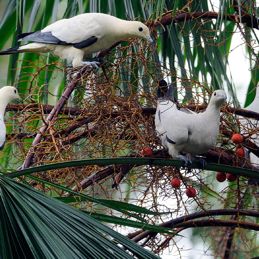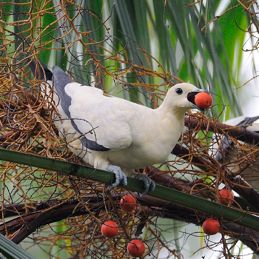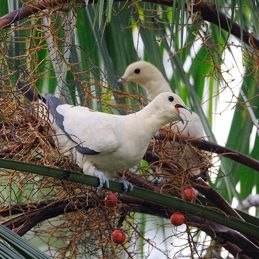Mark Chua had an exciting encounter with a flock of more than ten Pied Imperial Pigeons (Ducula bicolor) that descended on a palm tree in a garden in July 2008.
The palm appears to be a fan palm (Livistona sp.), whose ripe fruits are bright orange, each with a large seed. The pigeons obviously swallowed the fruits whole, the gizzard scraping off the flesh. And what about the seeds? My guess is that they would be regurgitated after a short while. Smaller seeds would pass through the gut to be ejected at the other end, but not large seeds.
The Pied Imperial Pigeon is a rare, non-breeding visitor to Singapore but a resident to Malaysia.
An earlier account of birds regurgitating seeds can be viewed HERE.
Images by Mark Chua.
This post is a cooperative effort between www.naturepixels.org and BESG to bring the study of bird behaviour through photography to a wider audience.













10 Responses
A flock always hang around intersection between Jurong Town Hall Road and AYE, near the International Business Park.
I see them often in the morning.
Serene’s flock are part of the free-flying population from the Jurong Bird Park. These birds stray out of the park during the day and can regularly be seen in that part of Jurong, as well as places like Tengah, Pasir Laba and Toh Tuck. They may also account for records from Kent Ridge.
Actual visitors to Singapore are scarce on the main island. Riau Archipelago birds regularly visit the southern islands, including Semakau and Salu. We also have a couple of records of Malaysian birds visiting the north-east areas, including Tekong.
In Johor, this species is mainly found off the east coast on islands that include Tioman. There are also records from the east coast proper, including the Sedili area.
Saw one imperial pied pigeon nesting on Jurong Hill on 22 Feb 2009. The nest is built on a tree just in front of the tower i.e. the one planted by Japanese Prime Minister Takeo Fukuda in 1977. The nest is small coz after pigeon sat on it, still can see its head/neck and tail. No idea of the nesting status i.e. whether egg already laid or not.
Is it safe to say that the free-flying imperial pied pigeon from Jurong Bird Park is breeding in Singapore? If yes, would its status be eventually changed from just Non-Breeding Visitor to also include Introduced Resident Breeder too?
As before, the 3 criteria for accepting an escape species as a feral for any checklist is :-
self-sustaining population
at least 10 years around
successful breeding in Singapore (outside areas of captive collections).
While the Pied Imperial Pigeon has been free-ranging for more than a decade and birds are to be found foraging on their own in various parts of south-west Singapore, most seem to return to the bird park at the end of the day (much like the huge free-ranging population of Cattle Egrets).
Additionally, this nesting record is not proven successful and is just above the bird park (Jurong Hill is considered as part of the bird park vicinity).
As numbers and sightings continue to increase and at more localities, it is probably just a matter of time before we do have a proper feral population in south-west Singapore….but not yet! This is also true for the Cattle Egrets.
Let’s all keep monitoring the situation.
I have just seen the same Bird-Park flock feeding on the same species of Livistona at NUS. They swallow the fruits whole and there is no sign of regurgitated seeds anywhere nearby. My guess is that the seeds pass right through the guts and are defecated. The fruits are c. 22 mm diameter and I have seen no other bird take them – not even the koels. Imperial pigeons may be the world’s best seed dispersal agents!
Thanks for the observation, Richard.
Hi.. I have been watching a pair of these pigeons feeding on the palm trees which are right beside my lounge windows. I was wondering what these beautiful birds are called, so I googled and glad to find this article answering all the questions I had in my curious mind 🙂 thank you so much. By the was I live in Jurong West near Gek Poh shopping centre, not very close to the birds park.
Dear Raza Zaidi – happy the website has been useful to you in identifying the pigeons. These are not very common around and you are fortunate to encounter them.